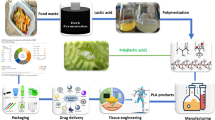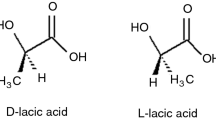Abstract
Polyethylene glycol (PEG) was first modified with bis(trimethoxysilylpropyl) amine as an effective coupling agent. Different compositions of PEG and polylactic acid (PLA) were then prepared through melt blending. The silane modification of PEG was confirmed by infrared spectroscopy. The SEM micrographs of different PEG/PLA compositions showed rather homogenous single phase morphology in the compositions with silane-modified PEG. The efficacy of silane-modified PEG maybe due to interfacial compatibilization of PLA and the silane-modified PEG. According to TGA and DSC thermograms, the PEG loading into PLA resulted in somewhat higher thermal stability and increase in the degree of crystallinity of up to 52%. The dynamic mechanical thermal analysis showed lower glass transition temperatures and higher toughness for all the silane-modified PEG/PLA compositions than that of the neat PLA. The biodegradation behavior of silane-modified PEG/PLA compositions increased linearly as evidenced by material weight loss either in water absorption or fungi associated destruction tests.
Graphical abstract










Similar content being viewed by others

References
R. Chandra, R. Rustgi, Biodegradable polymers. Prog. Polym. Sci. 23, 1273–1335 (1998)
J.J. Grodzinski, Biomedical application of functional polymers. React. Func. Polym. 39, 99–138 (1999)
S.S. Ray, M. Okamoto, Biodegradable polylactide and its nanocomposites: opening a new dimension for plastics and composites. Macromol. Rapid Commun. 24, 815–840 (2003)
I. Pillin, N. Montrelary, Y. Grohens, Thermo-mechanical characterization of plasticized PLA: Is the miscibility the only significant factor. Polymer 47, 4676–4682 (2006)
A. Zhu, P. Lu, H. Wu, Immobilization of poly(ɛ-caprolactone)–poly(ethylene oxide)–poly(ɛ-caprolactone) triblock copolymer on poly(lactide-co-glycolide) surface and dual biofunctional effects. Appl. Surf. Sci. 253, 3247–3253 (2007)
A. Lucke, J. Tebmar, E. Schnell, G. Schmeer, Biodegradable poly (D, L-lactic acid)-poly(ethylene glycol)-monomethyl ether diblock copolymers: structures and surface properties relevant to their use as biomaterials. Biomaterials 21, 2361–2370 (2000)
T. Kasuga, Y. Ota, M. Nogami, Y. Abe, Preparation and mechanical properties of polylactic acid composites containing hydroxyapatite fibers. Biomaterials 22, 19–23 (2001)
R. Gang, F. Si-Shen, Preparation and characterization of poly (lactic acid)-poly (ethylene glycol) microspheres for controlled release of microspheres. Biomaterials 24, 5037 (2003)
K. Bechtold, M.A. Hillmyer, W.B. Tolman, Perfectly alternating copolymer of lactic acid and ethylene oxide as a plasticizing agent for polylactide. Macromolecules 34, 8641–8648 (2001)
L. Gan, A. Geng, L. Jin, Q. Zhong, L. Wang, L. Xu, C. Mei, Antibacterial nanocomposite based on carbon nanotubes–silver nanoparticles-co-doped polylactic acid. Polym. Bull. 77, 793–804 (2020)
H. Liu, J. Zhang, Research progress in toughening modification of poly(lactic acid). J. Polym. Sci. Part B: Polym. Phys. (2011). https://doi.org/10.1002/polb.22283
Z.Y. Zhong, J. Zhang, Z.H. Gan, X.B. Jing, A novel rare earth coordination catalyst for polymerization of biodegradable aliphatic lactones and lactides. Polym. Int. 45, 60–66 (1998)
T.M. Quynh, H. Mitomo, L. Zhao, M. Tamada, Properties of a poly(L -lactic acid)/poly(D -lactic acid) stereocomplex and the stereocomplex crosslinked with triallyl isocyanurate by irradiation. J. Appl. Polym. Sci. 110, 2358–2365 (2009)
J.C.H. Lai, M.R. Rahman, S. Hamdan, Comparative studies of thermo-mechanical and morphological properties of polylactic acid/fumed silica/clay (1.28E) and polylactic acid/fumed silica/clay (1.34TCN) nanocomposites. Polym. Bull. 75, 135–147 (2018)
R. Li, Y. Wu, Zh. Bai, J. Guo, X. Chen, Effect of molecular weight of polyethylene glycol on crystallization behaviors, thermal properties and tensile performance of polylactic acid stereocomplexes. RSC Adv. 10, 42120–42127 (2020)
A. Khosravi, A. Fereidoon, M.M. Khorasani, M.R. Saeb, Experimental and theoretical mechanical behavior of compatibilized polylactic acid/polyolefin elastomer blends for potential packaging applications, Iran. Polym. J. 31, 651–663 (2022)
K.M. Choi, S.W. Lim, M.C. Choi, D.H. Han, C.S. Ha, Properties of poly(ethylene glycol)-grafted poly(lactic acid) plasticized with poly(ethylene glycol). Macromol. Res. 22, 1312–1319 (2014)
E. Piorkowska, Z. Kulinski, A. Galeski, R. Masirek, Plasticization of semicrystalline poly(l-lactide) with poly(propylene glycol). Polymer 47, 7178–7188 (2006)
S. Yan, J. Yin, Y. Yang, Z. Dai, J. Ma, X. Chen, Surface-grafted silica linked with l-lactic acid oligomer: a novel nanofiller to improve the performance of biodegradable poly(l-lactide). Polymer 48, 1688–1694 (2007)
B. Wang, T. Wan, W. Zeng, Dynamic rheology and morphology of polylactide/organic montmorillonite nanocomposites. J. Appli. Polym. Sci. 121, 1032–1039 (2011)
A. Bhatia, R.K. Gupta, S.N. Bhattacharya, H.J. Choi, An investigation of melt rheology and thermal stability of poly(lactic acid)/ poly(butylene succinate) nanocomposites. J. Appli. Polym. Sci. 114, 2837–2847 (2009)
K. Sungsanit, N. Kao, S.N. Bhattacharya, Properties of linear poly(lactic acid)/polyethylene glycol blends. Polym. Eng. Sci. 52, 108–116 (2012)
Y. Hu, Y.S. Hu, V. Topolkaraev, A. Hiltner, E. Baer, Crystallization and phase separation in blends of high stereoregular poly(lactide) with poly(ethylene glycol). Polymer 44, 5681–5689 (2003)
Z. Gui, Y. Xu, Y. Gao, C. Lu, S. Cheng, Novel polyethylene glycol-based polyester-toughened polylactide. Mater. Lett. 71, 63–65 (2012)
M. Baiardo, G. Frisoni, M. Scandola, M. Rimelen, D. Lips, K. Ruffieux, E. Wintermantel, Thermal and mechanical properties of plasticized poly(L-lactic acid). J. Appli. Polym. Sci. 90, 1731–1738 (2003)
D. Li, Y. Jiang, Sh. Lv, X. Liu, J. Gu, Q. Chen, Y. Zhang, Preparation of plasticized poly (lactic acid) and its influence on the properties of composite materials. PLoS One 13(3), e0193520 (2018)
B.W. Chieng, N.A. Ibrahim, W.M.Z.W. Yunus, M.Z. Hussein, Plasticized poly(lactic acid) with low molecular weight poly(ethylene glycol): mechanical, thermal, and morphology properties. J. Appl. Polym. Sci. 130, 4576–4580 (2013)
E. Ozdemir, J. Hacaloglu, Characterizations of PLA-PEG blends involving organically modified montmorillonite. J. Anal. Appl. Pyrolysis 127, 343–349 (2017)
W.B. Kusumaningrum, F.A. Syamani, L. Suryanegara, Heat properties of polylactic acid biocomposites after addition of plasticizers and oil palm frond microfiber. J. Kimia Sains dan Aplikasi 23(8), 295–304 (2020)
S. Wasti, E. Triggs, R. Farag, M. Auad, S. Adhikari, D. Bajwa, M. Li, A.J. Ragauskas, Influence of plasticizers on thermal and mechanical properties of biocomposite filaments made from lignin and polylactic acid for 3D printing. Composites Part B Eng. 205, 108483 (2017)
I.-G. Athanasoulia, P.A. Tarantili, Preparation and characterization of polyethylene glycol/poly(L-lactic acid) blends. Pure Appl. Chem. 89(1), 141–152 (2017)
S. Momeni, G.E. Rezvani, M. Shakiba, S. Shafiei-Navid, M. Abdouss, A. Bigham, F. Khosravi, Z. Ahmadi, M. Faraji, H. Abdouss, S. Ramakrishna, The effect of poly (ethylene glycol) emulation on the degradation of PLA/starch composites. Polymers 13, 1019 (2021)
S. Rodríguez-Llamazares, B.L. Rivas, M. Pérez, F. Perrin-Sarazin, Poly(ethylene glycol) as a compatibilizer and plasticizer of poly(lactic acid)/clay nanocomposites. High Perform. Polym. 24(4), 254–261 (2012)
M.-C. Choi, Plasticization of poly(lactic acid) (PLA) through chemical grafting of poly(ethylene glycol) via in situ reactive blending. Euro. Polym. J. 49(8), 2356 (2014)
F. Hassouna, J.-M. Raquez, F. Addiego, P. Dubois, V. Toniazzo, D. Ruch, New approach on the development of plasticized polylactide (PLA): grafting of poly(ethylene glycol) (PEG) via reactive extrusion. Euro. Polym. J. 47(11), 2134–2144 (2011)
X. Meng, N.A. Nguyen, H. Tekinalp, E. Lara-Curzio, S. Ozcan, Super tough PLA-silane nano hybrids by in situ condensation and grafting. ACS Sustain Chem. Eng. 6(1), 1289–1298 (2018)
M. Jakić, N.S. Vrandecic, M. Erceg, Thermal degradation of poly(3-hydroxybutyrate)/poly(ethylene oxide) blends: Thermogravimetric and kinetic analysis. Euro. Polym. J. 81, 376–438 (2016)
Author information
Authors and Affiliations
Corresponding author
Ethics declarations
Conflict of interest
The authors declare that the research leading to these results received funding from Iran Polymer and Petrochemical Institute under grant agreement No 35794115.
Additional information
Publisher's Note
Springer Nature remains neutral with regard to jurisdictional claims in published maps and institutional affiliations.
Rights and permissions
Springer Nature or its licensor (e.g. a society or other partner) holds exclusive rights to this article under a publishing agreement with the author(s) or other rightsholder(s); author self-archiving of the accepted manuscript version of this article is solely governed by the terms of such publishing agreement and applicable law.
About this article
Cite this article
Salimi, A., Ahmadi, S., Faramarzi, M. et al. Reactive blending of polylactic acid/polyethylene glycol toward biodegradable film. Macromol. Res. 31, 873–881 (2023). https://doi.org/10.1007/s13233-023-00174-1
Received:
Revised:
Accepted:
Published:
Issue Date:
DOI: https://doi.org/10.1007/s13233-023-00174-1



